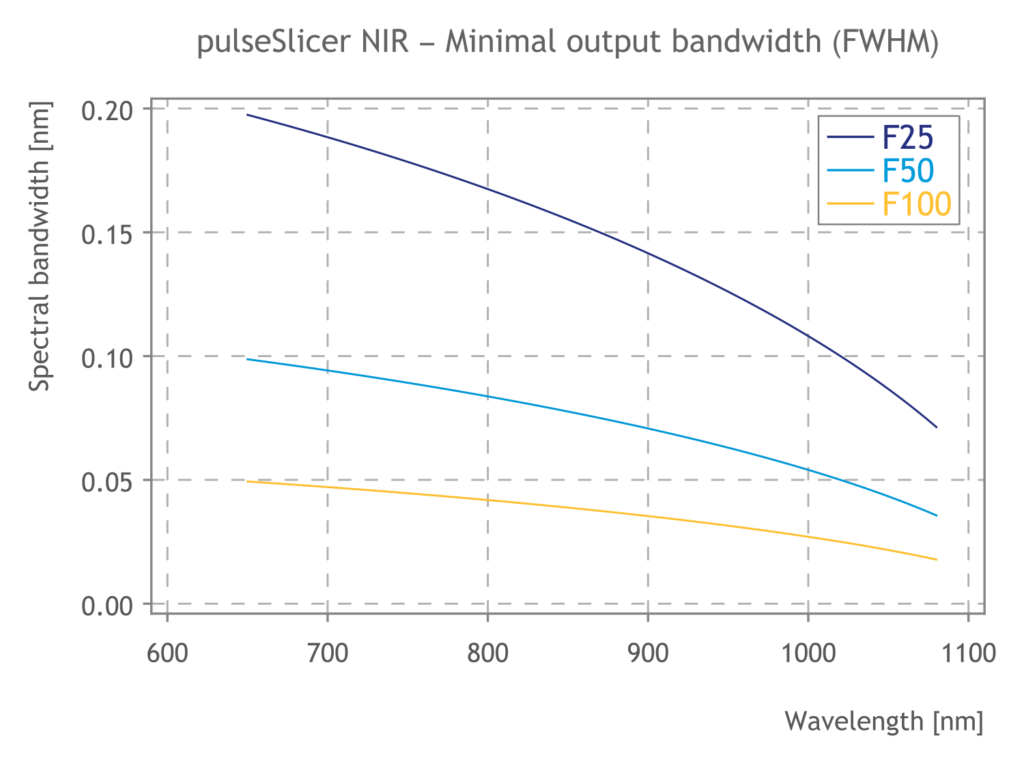pulseSlicer
Narrowing the Spectral Bandwidth of Pulsed Lasers by Spectral Cutting with a Spectrum Slicer / Laser Monochromator
Spectral Cutting with pulseSlicer
The principle task of the spectrum slicer (or laser monochromator) pulseSlicer is to cut out a very narrow spectral part of an ultra-short laser pulse. This function is similar to a band pass filter at a first glance. For example, in the spectral domain this could mean the narrowing of the spectral width of Ti:Sapphire pulses at 800 nm from Δλ = 7 nm to Δλ = 0.35 nm. In the time domain this corresponds with to a pulse stretching from approximately 140 up to 2700 fs.
Standard laser sources typically generate fixed or slightly variable pulses only. Therefore, the pulseSlicer acts as a spectrum slicer and is an economic solution for narrowing broadband laser pulses by spectral cutting. An optical system disperses the pulses spatially, and in the plane where the spectrum is spatially dispersed, the spectrum is controlled via a mask. Afterwards, the dispersed pulse is recollimated.
With the narrowing of the spectrum the spectral pulse width is modified accordingly, resulting in longer pulses. The transmitted power is reduced proportionally to the amount of spectral cutting, but many applications are not power limited when considering the available laser input power.
pulseSlicer in Combination with Pulsed Laser Sources
- Automized, narrow-band laser source
- Large wavelength tuning range
- User adjustable spectral bandwidth and output pulse durations
- High spectral power density compared to common lasers or OPOs
- High repetition rates (80 / 160 / 320 MHz) to cope with weak single-photon signal detection
At a Glance
- Easily variable output bandwidth / pulse duration
- Simple solution for narrowing broadband laser pulses
- Automated and software controlled
- TCP/IP software interface for easy remote automation

Specifications
| pulseSlicer NIR | F25 | F50 | F100 |
|---|---|---|---|
| Wavelength range | 650 nm … 1080 nm | ||
| Minimal bandwidth at 1000 nm | 0.11 nm | 0.06 nm | 0.03 nm |
| Static transmission | 50% … 70% between 700 nm … 1050 nm | ||
| Total transmission | Depends on slicing ratio | ||
| pulseSlicer IR | F25 | F50 | F100 |
| Wavelength range | 1000 nm … 1600 nm | ||
| Minimal bandwidth at 1550 nm | 0.17 nm | 0.08 nm | 0.04 nm |
| Static transmission | 50% … 70% between 1050 nm … 1600 nm | ||
| Total transmission | Depends on slicing ratio | ||
| Features for all pulseSlicer models: | |||
| Input beam polarization | Linear, horizontal, polarization rotator optional | ||
| Software and automation | Included | ||
| Remote control | Possible via TCP/IP interface | ||
Datasheets & Brochures
pulseSlicer_datasheet_rev-4.1.0 (pdf / english)
or
Email & Phone Contacts
APE has distributors around the world to give you the best support. Choose a country to find your local sales contact:



 The combination of the pulseSlicer and the tunable picosecond laser picoEmerald supports customers in the field of quantum research.
The combination of the pulseSlicer and the tunable picosecond laser picoEmerald supports customers in the field of quantum research.

